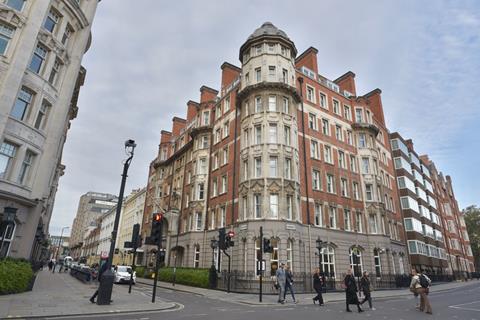TfL is due to introduce phase 2 of its Direct Vision Standard in October 2024 and it recently published the specifications for the Progressive Safe System (PSS) that trucks over 12 tonnes GVW that are rated below three stars for direct vision will need before entering London. Motor Transport in association with Brigade Electronics held a roundtable debate with a group of leading operators to discuss phase 2 and its expected impact.

Steve Hobson, editor, Motor Transport: Welcome to this roundtable in association with Brigade Electronics. Unfortunately TfL was unable to join us but we have experts here from Brigade and DAF Trucks who will be able to explain what a PSS will look like. Before we get going please introduce yourselves and say a few words about your fleet’s approach to phase 2.
Jacqui O’Donovan, MD, O’Donovan Waste Disposal: There is massive confusion in the industry which seems to think that if they fit a PSS it changes the star rating – it doesn’t.
Nigel Ponton, engineering manager, Cemex: We have recently taken on some new three star-rated vehicles and we have everything from zero to five star. In an ideal world my goal is to procure vehicles with a minimum of three stars but that is proving difficult at the moment.
Carl Milton, cement logistics manager – UK, Cemex: We have been on this journey since the early days with FORS and are concerned it is now going a little off-piste. There is a lot of confusion and lots of misconceptions out there in the industry.
Peter Cox, head of transport, CLEAN Linen Services: We are currently one star on all our vehicles but will have to fit PSS to all vehicles based at our two sites that service London including the new generation XB DAF’s we have on order that only meet 2 stars. We will still have one star rated trucks across the business so need to understand fully what the best approach would be.
The workhorses in our fleet are a mix of 12- and 18-tonners and one option is to stop using 18-tonners and run 12-tonners only in London. That option may make us less efficient on some routes because of volume constraints but it avoids all the problems with DVS… for now.
Karl Wilshaw, fleet director, Travis Perkins: We too have different star ratings across our UK fleet and where we can we will invest in higher spec vehicles and phase zero, one and two stars out, but as we stand today the zero, one and two stars in our legacy fleet will need a retro fit to achieve the PSS requirements.
Chris Cooling, senior transport manager, Day Aggregates: Our current fleet is a mix of zero to three star but the three star element is only 5%. We have one eye on what we retrofit and are working with Brigade on that but we are very conscious of the timelines to fit the PSS. The rising cost to serve is something we are looking at with our customer base now.
Chris Yarsley, senior policy manager on road freight regulation, Logistics UK: I’ve been dealing with DVS a lot this year and it’s been tough. I will explain today the success we’ve had ekeing out concessions from TfL and also the concerns we are putting to them about the status of the current kit fitted for the Safe System.
A lot of fleets with two-star vehicles have fitted a Safe System either for a FORS requirement or because they thought it was a good thing to do. We have one large fleet member that did this and are now thinking it was a wasted investment because they might have to rip it out and fit a PSS next year.
We have also queried if TfL have tested this enough. It appears from the Loughborough University documentation that there has only been one road-based test and that was not in London.
We have also been talking to London Councils which is the umbrella body that links the London boroughs and owns the traffic regulation on which the DVS is based.
James Ashford, head of UK connected services, Brigade Electronics: I can confirm that fitting a PSS will not change a vehicle’s star rating. A lot of people are confused and some suppliers have misinterpreted the specification.
It looks like you will need to replace some of your existing technology on the vehicle to meet the requirements of the PSS. If your vehicles are GSR compliant they will meet most of these requirements but there are subtle differences between GSR and DVS so there is some confusion here too.

Any vehicle with three stars that registered for a permit in 2020 will get a 10-year permit so will not need to be looked at until 2030. Anything below that will need a PSS. We along with Logistics UK have lobbied for a phased approach because trying to fit everything all at once will be a mistake. TfL will consider an extension for existing members until January 2025 but this is not set in stone and they will look at it in June 2024.
Looking at the wording of the PSS it has changed from the Safe System. A blind spot information system (BSIS) monitoring system must now be fitted to the nearside of the vehicle to completely eliminate remaining blind spots. But who deems if the blind spots are completely eliminated? Is that down to the fitter, TfL or a body like Logistics UK or the RHA? Or can suppliers just self-certify?
The BSIS must warn the driver if a collision is imminent eg if the vehicle turns towards a vulnerable road user (VRU) by a different and more urgent warning signal. If a VRU eg a cyclist is travelling parallel to the vehicle that does not present a risk of collision even though they are in close proximity. So it isn’t just about detecting VRUs, it is warning of potential collision.
You need a system that can monitor the direction of the vehicle and the VRU, predict when a collision is likely and give the driver adequate warning. But it must not pick up street furniture which a lot of the passive side detection systems still do. The system also needs to be active regardless of whether the driver is indicating.
So there will need to be a lot of re-education of the drivers as they have got used to these systems going off when there isn’t a danger but now they should only bleep when there is a real risk of collision.
Regulation 151 of GSR 2 also specifies a BSIS but there are differences between that and DVS. DVS starts from the side of the vehicle while GSR allows a 0.9m gap before the detection zone starts.
GSR has not been adopted in the UK yet. It has only been adopted by the EU states but it could be adopted in the UK. GSR systems have to be homologated by the OEM and cannot be retrofitted.
Mike Bennett, legislation engineer, DAF Trucks: TfL are saying GSR-compliant or DVS because if you start to overlay two different technologies you will overload the driver. So if you have a GSR 2 vehicle and then fit a DVS the systems could conflict.
GSR is a UN worldwide standard while DVS is a local law. It is difficult for TfL to argue that their local laws outstrip UN regulations.
O’Donovan: It is always us in London that get walloped. It’s tiresome.
Yarsley: We have explained our concerns at every level within TfL, from officer level all the way to Deputy Commissioner level. As a result of these approaches we have been able to guide the discussion and will work with TfL in the preparation of the market readiness report but we do need some decisions taken now on our concerns as businesses will be taking procurement decisions now.

Ashford: There must also be a Moving Off Information System (MOIS) at the front of the vehicle. This isn’t just about detecting VRUs, it must give a collision warning. TfL didn’t want the range to be too far ahead so it picks up the car in front but in London vehicles are bumper to bumper and there is never a 2m gap. Here too there are differences between the GSR and DVS specifications. DVS starts from the front of the vehicle and goes out 2m whereas the GSR says it must cover the vehicle front blind spot from a minimum of 1m to a maximum of 3.7 m from the front of the vehicle.
I also understand that certain MOIS under GSR can be temporarily deactivated whereas that is not allowed under DVS. So we have a UN mandated law which is being overwritten by London law.
O’Donovan: Why do we need this system if we have Class VI mirrors? Why did we put on two extra mirrors if we now have to put on another sensor? It already takes nine seconds for a driver to check all the mirrors. By the time he has done that in London he won’t get anywhere.
Wilshaw: These systems may for the first time have to tap into the vehicle CAN data to provide information which shows if the vehicle is moving off. We have all had the challenges when fitting telematics of accessing different manufacturers’ CAN data so we’d like to understand how the MOIS will interface with manufacturer’s CAN data?
Ashford: You can have a stand alone system that can be retrofitted to any vehicle.
Wilshaw: With a retrofit system you would have to know when the vehicle is moving off to meet the MOIS standard. How are we going to get that signal?
Ashford: We are currently having our MOIS solution independently tested. The BSIS is no problem but the front sensor system was not mandatory in the current spec so many suppliers are still finalising their solutions for MOIS as the technical spec was released late. The requirement for MOIS is quite prescriptive but we are hoping to have something by the end of the year.
Wilshaw: We haven’t found any product yet that is ready for market.
Ashford: We have had our BSIS independently tested and it will be DVS compliant for 2024 but for MOIS we are still developing our solution.
People are asking us what they should do if they have a Safe System fitted. We say replace the side detection system for a predictive system and look at a MOIS further down the line.
Time is ticking on and TfL have not addressed a lot of issues.
Ponton: If we wanted Brigade equipment fitted to 30 vehicles how would you handle it? We are all aware there is a massive shortage of skilled people at the moment.
Ashford: We only use qualified vehicle electricians who are part of our Brigade Service Partner network. There is no requirement under DVS for fitter competence and that is something we have raised with TfL. We are already fitting our new sidescan system Radar Predict which means when MOIS is ready there will only be one more system to do. The longer people leave it the worse it will be and then people will start taking chances with local garages.
Yarsley: I sent an email to TfL on May 5, the day after the technical meeting where we first saw the technical specifications. We do a lot of surveys and there has been a 30% drop in the number of vehicle technicians between Q3 2019 and Q3 2022. A lot have switched to driving because driver wages have gone up.
TfL has not acknowledged this and all they require are photos of the installation and a statement from a fitter which are completely pointless. Where are the checks and balances behind that statement to give the operator confidence that it is good quality equipment properly fitted?

Milton: Who will be checking – will it be at roadside stops?
Yarsley: If someone were to have a fatal accident the day after you issue them a Safety Permit where is the liability? It is a very grey issue.
Milton: It is an area where the police may not have had training and awareness.
Ashford: Another question we have been asked is ‘if the PSS is not working, does that mean the vehicle is off the road?’
Yarsley: It will be a DVSA and police spot check with TfL present as well. TfL does not have the powers to stop vehicles so the police will have to be there. We have asked them why they are putting so much resource into checking thousands of photos – they should take that resource and put it into enforcement. When you get an O-licence you sign an undertaking and you get punished severely if you are found to have broken it – do it that way and not have this massive effort upfront which proves nothing.
Ashford: Another issue is will the TfL website cope if everyone leaves it to the last minute and tries to upload all these photos?
Wilshaw: A consideration is not just the installation of new kit - a lot of operators with zero, one or two star vehicles have equipment fitted that will need to be decommissioned prior to any retrofit installations.
Ashford: I have asked TfL if they have factored in the two hours at £60 an hour it will take to decommission the old installation.
Bennett: There were 211,000 vehicles in scope as at last December so if you extrapolate that over the last 10 months we are probably talking nearer 330,000 that will need equipment fitting.
Yarsley: That is a at a cost of at least £1,500 each which is minimum cost of £300m.
We made the point when this came in that systems that are fitted to the vehicle for the PSS should be additive and not rip out and replace. The thinking now from DVS phase 1 to phase 2 is just rip it out but they need to think about the £300m and the implications for society at large.

Ponton: A lot of us have contract hauliers working for us and the sector is on its knees at the moment. Guys who operate one or two trucks are now expected to spend £2,000 or £3,000 to bring the vehicle up to the required standard in a given period of time. They are not making money now and those sums are just lunacy.
We are all for safety improvement but it has to be done in the right way.
Yarsley: TfL has already touted a 2028 revision to come in in 2030 so we don’t want them to say ‘actually, we got it wrong again’. The mayor has ‘Vision Zero’ of no one being killed or seriously injured on London’s roads and that includes road junction improvements, education campaigns and other things. But it feels like we are being disproportionately asked to contribute to this Vision Zero. Where are the other efforts such as educating cyclists not to go down the side of HGVs?
O’Donovan: That has been spoken about endlessly and the message is ‘we don’t want to put people off cycling by making them do cycling proficiency training’. When all these bleepers first came out driver overload was discussed then and it was dismissed. But it is now back on the agenda with FORS.
It’s a farce – we have Class V and VI mirrors and now we have to have more technology. We have spoken to the guy who fits our side scan systems and he hasn’t got a clue. Everything has 10-page technical specifications – you need to be Einstein. Loughborough has spoken about a phased approach – so why aren’t we doing it?
Ashford: All we can do is work in harmony with what TfL say.
O’Donovan: We shouldn’t be working in harmony with TfL because what they are saying is wrong. TfL said there used to be 12 accidents a year and now there are six but when I asked if that was down to the DVS they couldn’t answer. They haven’t even got the facts behind what they are doing.
We are putting people off joining the industry because there is so much bad press about fatalities.
Wilshaw: In reference to Brigade Electronics’ own PSS information you say equipment to meet the PSS should be E-marked [to certify it meets EU standards requiring components to be tested to make sure radiated emissions do not interfere with other electrical systems within the vehicle].
On review of the PSS documents nowhere in the specification does it say equipment has to be E-marked.
Emily Hardy, UK marketing manager, Brigade Electronics: It says you need to demonstrate that equipment does not adversely affect other safety-critical systems. An E-mark would meet that requirement.

Wilshaw: It’s not clear and it is open to interpretation whether or not it needs an E-mark.
Another area of confusion is in the specification for the camera monitoring system (CMS). One document clearly states now that it has to be on the nearside pillar. People already have the CMS display in the dashboard and now they are saying it has to be in a certain position. These are small details but an operator can fall foul of that.
It’s not just the view down the nearside. Some operators have multiple cameras fitted and the monitor is positioned to take a feed from those cameras which may be a reversing camera as an example. We have to consider the risks in overloading the driver with monitoring systems and now we are saying the blind spot camera monitor must be positioned close to a window edge or existing mirror location. There are guidelines but it is open to interpretation how you apply them.
Cox: Where does the DVSA fit into this? We have DVSA Earned Recognition but according to TfL that is the equivalent of FORS Silver – absolute rubbish. How can they tell us we don’t meet the Gold standard when we have accreditation from the DVSA?
Bennett: FORS don’t want to confuse the two standards. They want to be clear on what they stand for, what Earned Recognition is and what DVS stands for. They know there is confusion in the industry and they don’t want to muddy the waters by saying if you have FORS you will meet this other standard. They want to avoid any overlap.
Hardy: If you go back 10 or 15 years when the likes of Crossrail were coming out with their own specifications there were 10-plus different versions and we had customers coming to us asking ‘what do we need to fit to meet all these?’ We said ‘you can’t’ because there were so many of them. The idea of FORS and CLOCs was that there would be one standard and we seem to be moving away from that and now we have different specifications again.
Bennett: The TfL specification document has a habit of changing without warning so it is important to make sure you are looking at the latest version. This is partly as a result of lobbying on what is and is not practical and as we move into next year I expect to see more changes around vehicles that are equipped with GSR components.
You can’t apply for a new permit until July next year so in July we are going to have 300,000 vehicles needing permits. TfL are yet to say anything about administration and how they are going to make this system work. DAF has constantly nagged TfL to tell us what information we will need to give them. We can provide whatever they need but we can’t do it overnight.
They are moving to a web-based certificate so you can put your own details in and get your own certificate. We sent details of thousands of vehicles as a refresh to their database three weeks ago but have yet to see anything appear on their site. We are creating around 30 new declarations a day of star ratings as people register trucks with DVS.
GSR 1 was first introduced in 2014 and we are now in phase 2. The base regulation is a UN regulation that is being introduced by the EU. At the moment the UK hasn’t adopted it so non-GSR 2 compliant vehicles can operate in the UK though Northern Ireland is expected to adopt it when devolved government is restored.
There are three stages to GSR 2 – one comes into force next year and then there are two further stages, one in 2026 and another in 2029.
The MOIS comes in 2024 and DAF uses several bits of information including from a camera and a radar. Preparing to move off is triggered by the handbrake release, gear selection and throttle position. It looks at all three of those and determines if the driver is preparing to move off.
That is why it is very difficult for an aftermarket system to meet the MOIS regulation and that is why TfL has said if you have an OEM system they will accept it. If the driver moves off and there is a pedestrian there the system will apply the brakes and stop the truck.
The BSIS is far more advanced. It must now work at any speed not just up to 10kph and is much more intuitive, using AI as well as radar to warn of potential collisions.
There must also a reversing information system – basically a camera – and a tyre pressure monitoring system which has been an option on all our vehicles and will become mandatory next year under GSR 2.

Milton: We have been fitting TPMS for 10 years and it has reduced our blowouts by 90%.
Bennett: A lot of this is moving towards autonomous driving and cyber security will be very important for that.
So at DAF we have Side Assist for moving right or left, Turn Assist which is integrated into Side Assist, Reverse Assist, Advanced Emergency Brake Assist for when a person steps off the footpath and an information data recorder which is basically a black box to record what is happening with the vehicle.
The XG cab has two stars and because of its size it will never get three stars. It will be GSR 2 compliant from week one next year so will then meet the requirements of the PSS with the exception of the left turn audible warning. That is something we will offer as a factory fitment option.
Our tippers and grab loaders can meet three stars with the right specification including the DAF Digital Vision System [cameras and monitors replacing the Class II and IV rear view mirrors] and we have seen a big take up of those. We are having an argument with TfL about Digital Vision as the guidelines talk about UN Regulation 46 [covering the use of camera monitoring systems to replace Class II mirrors].
My argument is that Reg 46 covers both cameras and mirrors so you can’t differentiate between the two – but they have done. I’m saying to them that Reg 46 says cameras and mirrors are equal and that in fact if you compare the vision available from a camera with that available from a mirror there is about a 4% difference in what you can see.
The LF range is being replaced with the new XB and that can achieve three stars at 14 and 16 tonnes. The standard 18-tonne XB is two-star but with GSR compliance will meet the PSS specification or you can have a three-star 18-tonner though there will be compromises on front axle loading.

Because GSR has not been adopted in the UK all the GSR options are deletable. I don’t think many people will take that option as it seems counter-intuitive to remove safety systems.
GSR is on the list of EU laws to be brought into effect in the UK but there is a high volume of laws on the waiting list. It will get there eventually.
As a manufacturer we can supply new vehicles that meet the requirements of DVS but there will be a huge challenge administering the scheme and supporting current customers as they transition their existing vehicles.
Yarsley: That is why we are happy that we got them to agree to do the market readiness report from April to June next year. The goal would be to have such a convincing report showing the market is not ready that London Councils will put a pause on it. We are trying to make London Councils aware that they need to act and ask the questions. London Councils own the DVS and that is where we need to concentrate all our efforts to prove that this is not implementable in the timeframes TfL want.
Hobson: Thank you all for your time and contributions today and we will put some of the questions raised today to TfL on your behalf.
TfL responds to questions raised

TfL was unable to attend the roundtable but has responded in writing to some of the key questions raised.
Why are the DVS requirements for the Blind Spot Information System (BSIS) and Moving Off Information Systems (MOIS) different from those in the GSR?
The mayor, through his Vision Zero action plan and transport strategy has committed to ensuring that no one is killed or seriously injured on London’s road network by 2041. DVS and the HGV Safety Permit Scheme are instrumental to this, by reducing fatal collisions where vision is a contributing factor by three quarters between 2018 and 2023. We will continue to take every possible measure to eradicate deaths and serious injuries from our roads and enhancing the safe systems for HGVs will help us do so. This is why we have decided to implement BSIS and MOIS sooner than GSR requirements to reduce road deaths.
The technical specifications for both MOIS and BSIS are based upon UNECE R151 and R159 and were developed by Loughborough University after conducting extensive in house and on street tests and are more advanced than requirements under GSR.
We set out clear technical specifications for both MOIS and BSIS which were tested with our industry partners and trade bodies at the DVS working group on 24 May 2023 and which were subsequently approved by London Councils Transport and Environment Committee (TEC). The final technical specifications were published on 4 September 2023.
Will TfL issue permits to vehicles that are built to comply with GSR without the need to either achieve 3 stars or install a PSS?
The objective of the PSS is to reduce the risks that HGVs with the lowest levels of direct vision present to vulnerable road users. We have been clear that to obtain a permit to operate in Greater London, any HGV over 12 tonnes rated zero, one or two stars must fully comply with the requirements of the PSS. This applies irrespective of whether the vehicle complies with the GSR requirements as the PSS includes additional safety features.
Will trucks being fitted with a Safe System in the next 12 months be granted any derogation from the October 2024 deadline or will they be required to replace a nearly new SS with a PSS?
Operators fitting safety equipment to vehicles now do not need to wait until October 2024 to fit the PSS equipment and we recommend that if you need to fit the PSS, you do so at the earliest opportunity. The PSS is based on the equipment used in the existing Safe System but with additional equipment needed such as the MOIS. The PSS therefore meets (and goes beyond) the requirements of the current safe system.
As set out in our DVS Operator’s Guidance, for zero, one and two star rated vehicles the Safe System permit remains valid until midnight on 27 October 2024. If operators choose to fit the PSS to vehicles now, they can apply for a safety permit now that will cover their vehicles up until October 2024.
We are working towards ensuring operators can apply for new safety permits from June 2024. The equipment will be sufficient for that permit, provided it complies with the PSS requirements as set out in the DVS operator’s guidance and detailed specifications.
In consultation with the industry, we have also offered a three-month grace period for operators to fit PSS equipment. Operators may only take up this grace period if they can prove that a vehicle has been booked into a fitter for equipment to be attached to an HGV and that the fitter is unable to complete the job prior to the 27 October 2024. A booking conformation e-mail is sufficient proof. We will announce further details about the grace period in due course.
Who will prepare the market readiness report for London Councils and when will it be ready? Operators are concerned that the clock is already ticking to install the PSS to perhaps 300,000 vehicles and if the report is not done until July that will just add to delays.
The mayor announced in the Vision Zero action plan in 2019 that the DVS standard would be raised from one to three stars from October 2024. We consulted on the form and content of the PSS in spring this year, and the enhanced threshold requirements and PSS were then approved by London Councils on 8 June 2023 and will be enforced from 28 October 2024. We estimate that at least 300,000 vehicles operating in London are rated as zero, one and two stars as of September 2023. Early conversations with our partners in industry suggest that operators are starting to work towards fitting equipment needed to meet the PSS requirements.
We have already committed to providing an assessment of the industry’s readiness for the enhanced requirements. This will be undertaken by TfL in consultation with the industry and will form part of our recommended approach to the grace period for London Councils Transport and Environment Committee to decide on in June 2024.
Will there be any requirement for independent tests of equipment used in a PSS? Does the equipment have to be CE marked? Will there be any checks on the competence of installers of PSS?
The equipment needs to meet the technical specifications for the PSS as set out in our updated operator’s guidance. We do not require any independent tests of equipment to be fitted as part of the PSS, and it does not need to be CE marked. Our information requirements to show the PSS has been fitted are set out in the DVS operator’s guidance.
Will police and DVSA be checking if vehicles’ PSS are actually performing as per the DVS in roadside checks or will it simply be a case of ANPR checking a database that a vehicle either has 3 stars or has been declared by the operator to have a PSS?
Enforcement is currently and will continue to be carried out in three ways:
• Automatic number plate recognition (ANPR) system – checking the vehicle registration mark of each HGV entering and operating in Greater London against the DVS permit database
• TfL compliance officers conducting checks on vehicles entering TfL sites
• Met Police Commercial Vehicle Unit conducting roadside checks on HGVs entering and operating in Greater London
The focus of this activity is on checking whether vehicles have a permit and that (Progressive) Safe System equipment is properly fitted. You can find out more about TfL’s enforcement policy for DVS on our website.
Will there be any standardisation of the displays and audible warnings in the cab so drivers who routinely switch vehicles know what each system is telling them?
No. We do not consider it appropriate for TfL to suggest a product or brand of equipment that should be installed as part of the PSS, as this would increase our role to that of the licensing authority without having the relevant powers to do so. It would also add further costs to manufacturers and suppliers for demonstrating compliance, and increase complexity, making the scheme more burdensome for operators and fitters to navigate.
TfL has instead standardised the system detecting vulnerable road users through its technical specifications for BSIS and MOIS. This includes the standardisation of where in cab monitors should be placed within the cab, and the types of information they must display regardless of supplier.













